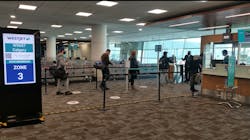2022 Airport Business Project of the Year: PQS Puts Boarding Info in Passengers' Hands
With physical distancing put in place to mitigate the spread of COVID-19, the line of passengers waiting to board a wide-body aircraft could be a half mile long. Boarding typically is considered an airline function, but with 6 feet required between passengers, Toronto – Lester B. Pearson International Airport (YYZ) was motivated to take a collaborative approach.
“Our primary concern was the space required to property distance passengers,” said Pierre Lanthier, director of IT strategy and innovation for the Greater Toronto Airports Authority (GTAA).
“We thought, ‘Why can’t we put the control of boarding into the hands of the passenger?’” he said. By giving passengers more timely boarding information, he said the hope was to alleviate the nervous tension that caused passengers to form a long line as soon as they heard a boarding announcement.
GTAA collaborated with its strategic IT partner, Wipro Limited, to create a cloud-based Passenger Queue System (PQS) designed to improve the boarding experience and discovered the system has other benefits as well.
The PQS project was completed between April and November 2021. The initial implementation, April to June 2021, included Westjet gates B25 and B27.
To use the PQS, passengers with a mobile device scan a QR code. They then have updated boarding information in hand without needing to install an app or even update their browser.
With information in hand, they don’t need to swarm the gate to hear announcements on the PA or see the overhead gate screen. Instead of lining up or crowding the gate, they can sit nearby or walk around. “They could be shopping – they could be doing any number of things,” Lanthier said.
Buy-in from passengers during the initial phase was almost immediate and the airline benefitted as well, he said.
Westjet reported:
Improvement in OTP (on-time performance) with zero delays on gates utilizing the PQS system.
86% of flights collected ancillary revenue (upgrades were offered to guests before boarding).
Gates with PQS met ATPDR (accessible transportation for persons with disabilities regulations) requirements with boarding announcement and zones visible to all guests.
Agents made fewer announcements and noticed a significant decrease in questions about boarding.
Post project completion, the PQS was deactivated with the idea of reintroducing it on a larger scale. Lanthier said GTAA is looking to deploy PQS at other gates. Initially, PQS was a standalone application. That could and likely will change in the future. “We are building PQS into our overall Departures strategy,” he said.
And, there are considerations for more targeted communication. From an airport perspective, “Concession revenue is very important,” he said. GTAA is looking at how it might use the PQS to increase revenue opportunities, whether that’s sending coupons to a mobile device or messages to passengers letting them know they have time to visit the lounge.
The Tech Behind PQS
The PQS has three components:
- Airline PQS portal – The portal allows the airline agent at the gate to login and set up the flight, select preboarding messages and go through the boarding process using a tablet provided at the gate or using the CUPPS (common use passenger processing system) workstation. The airline PQS portal is a cloud native application developed using AWS (Amazon Web Services).
- Large display stand and screen at the gate. Scheduled flight information, preboarding messages and current boarding information can be displayed in real-time based on the inputs provided to the PQS portal by the airline agent at the gate. When not in use for boarding, the display can show airport messaging or advertising. Content management, scheduling and the display uses the cloud-based Omnivex Ink platform and LG’s WebOS platform.
- QR-invoked boarding information page for mobile devices. Passengers can scan the QR code available at strategic locations, including check in and boarding gate, and have real-time boarding information on their mobile device serviced by Omnivex Ink.
One of the reasons GTAA could put the PQS in place so quickly is it already had a strategic IT partner. GTAA chose Wipro as its strategic IT partner in 2016 and signed a 9-year contract.
Anudeep Kambhampati, general manager – Transportation Sector Canada with Wipro, said, “If you look at why Toronto Pearson was able to do a project like this in the middle of pandemic and not a lot of airports attempted something like this, I think that goes back to the vision they had. They wanted to have an IT partner like Wipro working with them to really bring in that organizational capability to make these kind of things happen. Airports want to focus on their core business, and IT is not their core business. We take care of the complete IT.”
Wipro took the PQS concept, brought in partners, and created and implemented the technical solution.
In the midst of a pandemic, Dipen Ghetia, innovation program manager with Wipro, said changes in the aviation sector were daily, staffing among the stakeholders was less and new government regulations were being implemented.
Ghetia said the challenge of bringing stakeholders together was addressed by showcasing the promise that was there. “We did not take a traditional project approach, where usually you spend months figuring out all the requirements for the project,” he said. “And then you spend months developing something. We didn’t have that time or luxury of investment of effort from everybody.” Instead, he said Wipro turned the concept into an IT solution using Agile methodology, obtained stakeholder feedback, made updates and implemented the technology in about 30% of the time a traditional project might take.
Wipro was able to fast-track the development of PQS through a crowdsourcing platform within the company of almost 230,000 employees, he said.
According to Ghetia, the completely cloud native and serverless system leveraging Wipro FullStride Cloud Services, AWS and Omnivex Ink platform is a first for Toronto Pearson and uncommon in North American airports.
- Location: Toronto – Lester B. Pearson International Airport (YYZ)
- Project: Passenger Queue System (PQS)
- Completion: June 2021
- Key Participants: Greater Toronto Airports Authority, Wipro, Omnivex
About the Author
Rebecca Kanable
Assistant Editor
Rebecca Kanable, a veteran journalist, worked with Endeavor Business Media's aviation group from 2021 to 2024 as assistant editor of Airport Business, AMT and Ground Support Worldwide. She previously worked for various publications, including trade magazines and newspapers.

